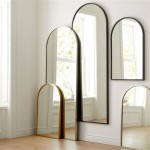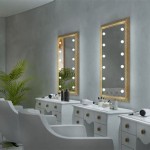The Strategic Use of Mirrors on Walls in Bedroom Design
Mirrors have long been utilized as design elements in interior spaces, serving both functional and aesthetic purposes. In the bedroom, their placement and size can significantly impact the perceived dimensions, light levels, and overall ambiance. The deliberate incorporation of mirrors necessitates careful consideration of room layout, lighting sources, and personal preferences to achieve the desired effect.
The strategic positioning of mirrors on bedroom walls can address several design challenges. Small bedrooms can benefit from the illusion of increased space, while darker rooms can exploit reflected light to enhance brightness. Furthermore, mirrors can act as focal points, drawing attention to specific areas or design features within the room. However, improper placement can lead to undesirable reflections or a cluttered visual effect, thus requiring meticulous planning prior to installation.
Maximizing Space and Light with Mirrors
One of the primary benefits of using mirrors in a bedroom is their ability to create the illusion of greater space. This is particularly advantageous in smaller bedrooms where actual square footage is limited. A large mirror positioned strategically on a wall can effectively double the perceived size of the room. The reflection creates a visual depth that tricks the eye into perceiving a larger area than physically exists.
To maximize this effect, consider placing a large mirror on one of the longer walls of the bedroom. This will create a sense of expansiveness and can visually stretch the room. Alternatively, a mirrored wall behind the bed can create a dramatic statement and open up the space significantly. The key is to ensure that the mirror reflects a visually appealing area of the room, such as a window or a well-decorated corner. Avoid reflecting cluttered areas or features that are not aesthetically pleasing.
Mirrors also play a crucial role in enhancing the natural and artificial light within a bedroom. In rooms with limited natural light, placing a mirror opposite a window can help to reflect and distribute sunlight throughout the space. This can brighten up the room and create a more cheerful and inviting atmosphere. The angle of the mirror should be carefully considered to capture the maximum amount of sunlight and minimize glare.
The use of mirrors to amplify artificial light is equally important. Strategically positioning mirrors near light fixtures, such as lamps or sconces, can enhance the overall brightness of the room. The reflected light will bounce off the mirror and illuminate darker corners, creating a more evenly lit and welcoming environment. This is particularly useful in bedrooms that are primarily used during the evening hours.
Creating Focal Points and Enhancing Décor
Mirrors can function as effective focal points within a bedroom, drawing attention to specific areas or design features. A strategically placed mirror can highlight an interesting piece of furniture, a decorative artwork, or an architectural detail. This can add visual interest to the room and create a sense of visual hierarchy.
Consider using a decorative mirror with an ornate frame to create a focal point above a dresser or nightstand. The mirror can enhance the aesthetic appeal of the furniture and add a touch of elegance to the room. Alternatively, a series of smaller mirrors arranged in a gallery wall style can create a visually striking focal point on a blank wall. The mirrors can be of varying shapes and sizes to add visual interest and texture.
Mirrors can also be used to enhance the existing décor in a bedroom. A mirror placed behind a vase of flowers or a decorative sculpture can reflect the colors and textures, creating a more vibrant and dynamic display. This can add depth and dimension to the décor and create a more visually appealing arrangement.
When using mirrors to enhance décor, it is important to consider the overall color palette and style of the room. The mirror should complement the existing décor and not clash with the overall aesthetic. Choose a mirror frame that matches the style of the furniture and the color scheme of the room. For example, a minimalist bedroom might benefit from a simple, frameless mirror, while a more traditional bedroom might benefit from a mirror with an ornate, gilded frame.
Practical Considerations for Mirror Placement and Installation
Prior to installing mirrors in a bedroom, several practical considerations must be addressed. The size and shape of the mirror should be carefully chosen to suit the dimensions of the wall and the overall proportions of the room. A too-large mirror can overwhelm a small room, while a too-small mirror can appear insignificant and ineffective.
The height at which the mirror is mounted is also important. The mirror should be positioned at a height that allows the viewer to see their reflection comfortably. For a full-length mirror, the bottom of the mirror should be close to the floor, while the top should be high enough to capture the entire reflection. For a smaller mirror, the center should be positioned at eye level.
The installation process should be carried out carefully to ensure that the mirror is securely mounted to the wall. Mirrors can be heavy and fragile, and improper installation can lead to accidents and damage. It is recommended to use professional installation services, especially for large or complex mirror installations. Ensure that the wall is strong enough to support the weight of the mirror and that the mounting hardware is appropriate for the type of wall material.
Furthermore, the surrounding environment of the mirror must be considered. Avoid placing mirrors in areas where they are likely to be exposed to moisture or excessive heat. These conditions can damage the mirror surface and cause it to deteriorate over time. Similarly, avoid placing mirrors in areas where they are likely to be bumped or scratched. This can damage the mirror and detract from its aesthetic appeal.
Regular maintenance is essential to keep mirrors looking their best. Clean the mirror surface regularly with a glass cleaner and a soft cloth to remove dust and fingerprints. Avoid using abrasive cleaners or scouring pads, as these can scratch the mirror surface. Inspect the mounting hardware regularly to ensure that the mirror is securely attached to the wall. If any damage is detected, take steps to repair it promptly to prevent further damage or accidents.
The psychological effects of mirrors should also be taken into account. Some individuals may find the constant reflection of themselves in a bedroom to be unsettling or distracting. If this is the case, consider limiting the number of mirrors in the room or positioning them in less conspicuous locations. It is important to create a bedroom environment that is conducive to relaxation and rest, and the placement of mirrors should contribute to this goal.
Finally, consider the safety aspects of mirrors, especially in households with children or pets. Ensure that mirrors are securely mounted to the wall to prevent them from falling and causing injury. Consider using shatterproof mirrors or applying a safety film to the back of the mirror to prevent shards of glass from scattering if the mirror is broken. These measures can help to minimize the risk of accidents and injuries.

Mirror Wall Panel Ideas To Elevate Your Living Space

Ped With Dated Mirrored Walls 5 Design Ideas To Make Them Work Apartment Therapy

Pin On Home Style And Design

Add Style And Depth To Your Home With Mirrored Walls

How To Decorate With Mirrors Decorating Ideas For

Inspiration On How To Build Your Bedroom Mirror Wall

25 Mirror Decor Ideas From Designer Rooms

Bedroom Mirror Designs That Reflect Personality

How To Decorate Your Bedroom With Mirrors 8 Tricks And 31 Example Digsdigs

Decorative Wall Mirrors For Fascinating Interior Spaces








